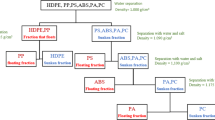Abstract
Most landfilled plastic waste is a mixture or is in the form of composites with incombustible wastes such as glass, metals, and ceramics. After hydrothermal treatment, including a steam-explosion process, the separation of mixed waste (MW) into organic and inorganic substances becomes easy. However, the effect of hydrothermal pretreatment on the subsequent liquefaction of organic substances from MW is not obvious. In this study, the effects on the liquefaction of polystyrene and high-density polyethylene are discussed. Moreover, optimum conditions for the liquefaction of organic substances from hydrothermally treated MW are identified. By means of this hydrothermal pretreatment, including the steam-explosion process, polystyrene and high-density polyethylene can be significantly converted to oil by liquefaction at 300°–400°C. In comparison with liquefaction of hydrothermally pretreated mixed waste (HMW) at 300°–400°C with a batch type reactor, the yield of oil increases significantly on liquefaction using a semi-batch type reactor. It is considered that the radical chain and termination reactions among the radicals from HMW were inhibited in the semi-batch type reactor. On liquefaction of HMW in a semi-batch reactor, the conversion of HMW to oil was enhanced on increasing the liquefaction temperature to 350°C and the holding time to 60 min.
Similar content being viewed by others
References
Plastic Waste Management Institute (Japan). Flowchart of plastic products, plastic waste and resource recovery (2005). http://www2.pwmi.or.jp/siryo/ei/ei_pdf/ei34.pdf
Ministry of the Environment, Government of Japan. State of Discharge and Treatment of Municipal Solid Waste in FY 2003 (2005). http://www.env.go.jp/en/press/2005/1104a.html
Lilac WD, Lee S (2001) Kinetics and mechanism of styrene monomer recovery from waste polystyrene by supercritical water partial oxidation. Adv Environ Res 6(1):9–16
Park Y, Hool JN, Curtis CW, Roberts CB (2001) Depolymerization of styrene-butadiene copolymer in near-critical and supercritical water. Ind Eng Chem Res 40(3):756–767
Fang Z, Kozinski JA (2001) A comparative study of polystyrene decomposition in supercritical water and air environments using diamond anvil cell. J Appl Polymer Sci 81(14):3565–3577
Kwak H, Shin H-Y, Bae S-Y, Kumazawa H (2006) Characteristics and kinetics of degradation of polystyrene in supercritical water. J Appl Polymer Sci 101(1):695–700
Kronholm J, Vastamaeki P, Raesaenen R, Ahonen A, Hartonen K, Riekkola ML (2006) Thermal field-flow fractionation and gas chromatography-mass spectrometry in determination of decomposition products of expandable polystyrene after reactions in pressurized hot water and supercritical water. Ind Eng Chem Res 45(9):3029–3035
Watanabe M, Hirakoso H, Sawamoto S, Adschiri T, Arai K (1998) Polyethylene conversion in supercritical water. J Supercrit Fluid 13(1–3):247–252
Moriya T, Enomoto H (1999) Characteristics of polyethylene cracking in supercritical water compared to thermal cracking. Polymer Degrad Stabil 65(3):373–386
Watanabe M, Mochiduki M, Sawamoto S, Adschiri T, Arai K (2001) Partial oxidation of n-hexadecane and polyethylene in supercritical water. J Supercrit Fluid 20(3):257–266
Watanabe M, Sawamoto S, Adschiri T, Arai K (2001) Polyethylene conversion by partial oxidation in supercritical water. J Mater Cycles Waste Manag 3(2):99–102
Su X, Zhao Y, Zhang R, Bi J (2004) Investigation on degradation of polyethylene to oils in supercritical water. Fuel Process Technol 85(8–11):1249–1258
Su L, Wu X, Liu X, Chen L, Chen K, Hong S (2005) An investigation on polypropylene degradation in supercritical water adding benzoyl peroxide. Chinese J Chem Eng 13(6):845–848
Su L, Wu X, Liu X, Chen L, Chen K, Hong S (2007) Effect of increasing course of temperature and pressure on polypropylene degradation in supercritical water. Chinese J Chem Eng 15(5):738–741
Sato Y, Kato K, Takeshita Y, Takahashi K, Nishi S (1998) Decomposition of poly(vinyl chloride) using supercritical water. Jpn J Appl Phys 1 37(11):6270–6271
Takeshita Y, Kato K, Takahashi K, Sato Y, Nishi S (2004) Basic study on treatment of waste polyvinyl chloride plastics by hydrothermal decomposition in subcritical and supercritical regions. J Supercrit Fluid 31(2):185–193
Sugano M, Tsubosaka M, Shimizu S, Fujita M, Fukumoto T, Hirano K, Mashimo K (2008) Dechlorination of chloroprene rubber by co-liquefaction with natural rubber containing zinc oxide. Energ Fuel 22(3):1986–1990
Janke G, Frendel A, Schmidt-Naake G (1999) Polymer modification in a vibratory mill. Chem Eng Technol 22(12):997–1000
Frendel A, Schmidt-Naake G (2001) Controlled molecular weight degradation by vibration grinding. Chem Eng Technol 24(8):798–803
Struik LCE (1987) Volume relaxation and secondary transitions in amorphous polymers. Polymer 28(11):1869–1875
Author information
Authors and Affiliations
Corresponding author
Additional information
Chemical Feedstock Recycling & Other Innovative Recycling Techniques 6
Rights and permissions
About this article
Cite this article
Sugano, M., Komatsu, A., Yamamoto, M. et al. Liquefaction process for a hydrothermally treated waste mixture containing plastics. J Mater Cycles Waste Manag 11, 27–31 (2009). https://doi.org/10.1007/s10163-008-0215-3
Received:
Accepted:
Published:
Issue Date:
DOI: https://doi.org/10.1007/s10163-008-0215-3




